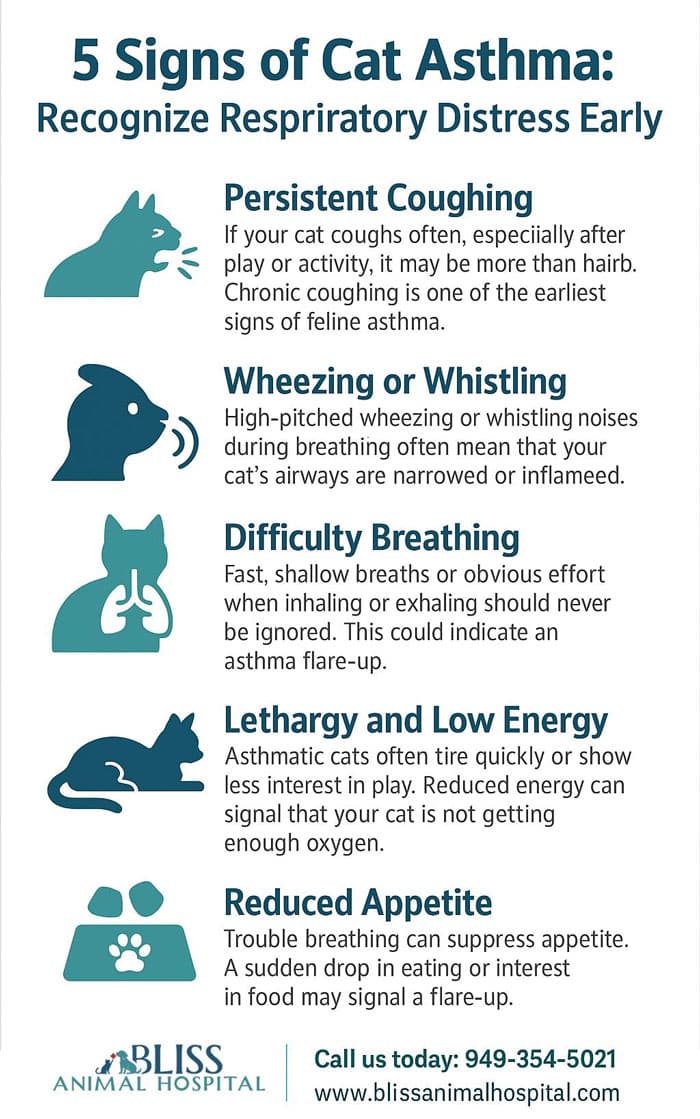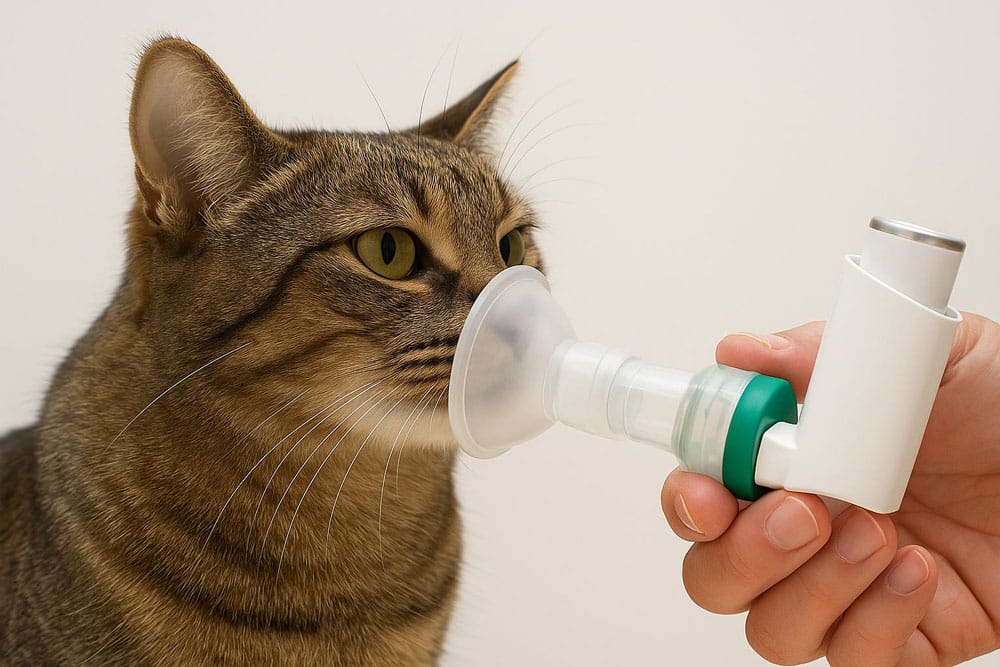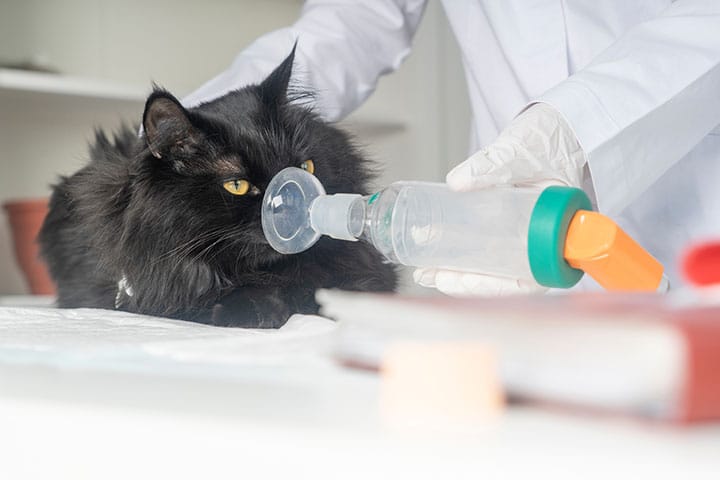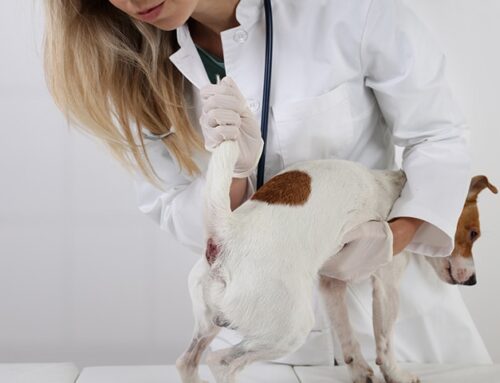Feline Asthma in Cats: Symptoms, Treatment, and Care in Orange County, CA
Top 3 Takeaways
Introduction
If you’ve noticed your cat coughing, wheezing, or breathing rapidly, you may be witnessing early signs of feline asthma. Also known as feline bronchitis, this chronic respiratory condition is more common than many pet parents realize and, if left untreated, can significantly affect a cat’s comfort and quality of life.
At Bliss Animal Hospital, our team understands how alarming it can be to see your cat struggle to breathe. The good news is that with prompt diagnosis, tailored treatment, and ongoing care, most cats with asthma can lead full, active, and happy lives. This guide explains what feline asthma is, its symptoms and causes, available treatments, and how we support cats and their families here in Orange County.
What Is Feline Asthma?
Feline asthma is a chronic, inflammatory disease that affects the lower airways of the lungs. It occurs when a cat’s immune system overreacts to an allergen, causing the airways to become inflamed, narrowed, and filled with mucus. This leads to labored breathing, coughing, and wheezing.
Some pet parents refer to the condition as feline bronchitis, and while the two terms are often used interchangeably, they describe slightly different processes. Asthma typically involves reversible airway constriction, while chronic bronchitis is more about persistent inflammation. Many cats experience a combination of both, which is why accurate diagnosis and a tailored treatment plan are so important.
Feline asthma is a lifelong condition. While there’s no cure, effective treatment and careful environmental management can keep flare-ups under control, allowing cats to live comfortably for many years.

Figure 1: Illustration of a cat experiencing breathing difficulty during a feline asthma episode.
Causes and Risk Factors
Feline asthma develops when a cat’s immune system becomes hypersensitive to something it inhales. This hypersensitivity triggers inflammation and narrowing of the airways, making it harder for air to pass through the lungs.
Several factors can increase a cat’s risk of developing asthma:
Understanding what sets off your cat’s symptoms is a key part of managing asthma effectively. At Bliss Animal Hospital, we often recommend a thorough review of your home environment to identify and minimize potential triggers.
Symptoms of Feline Asthma
Asthma symptoms can range from mild and occasional to severe and life-threatening. Early recognition makes a significant difference in long-term management and prognosis.
The most common signs of feline asthma include:
A helpful tip is to watch for the frequency and context of coughing episodes. Unlike hairball coughs, asthma-related coughing often doesn’t result in anything being produced and may occur during rest or sleep.

Figure 2: Bliss Animal Hospital infographic highlighting the five key signs of feline asthma to help pet owners recognize respiratory distress early.
How Is Feline Asthma Diagnosed?
Diagnosing asthma in cats requires a careful, step-by-step approach. Since several other conditions—such as respiratory infections, heart disease, and lungworm—can mimic asthma symptoms, an accurate diagnosis is essential for proper treatment.
At Bliss Animal Hospital, we use a combination of diagnostic methods, including:
With these tools, our veterinary team can confirm the diagnosis and create a personalized plan to keep your cat breathing more comfortably.
Treatment Options
Asthma is a chronic condition, but with the right approach, it can be successfully managed. Treatment focuses on reducing inflammation, minimizing triggers, and preventing acute flare-ups.
Corticosteroids
Corticosteroids are the cornerstone of asthma treatment because they reduce airway inflammation and mucus production. Inhaled steroids, such as fluticasone administered through a feline-specific inhaler, are often preferred because they deliver medication directly to the lungs with minimal side effects. Oral or injectable steroids may be used in more severe cases or during the early stages of treatment.
Bronchodilators
Bronchodilators help relax the muscles around the airways during acute episodes, making it easier for your cat to breathe. These are typically used alongside corticosteroids for comprehensive management.
Environmental Management
Reducing exposure to known triggers can greatly decrease the frequency and severity of asthma attacks. Practical steps include using HEPA filters, choosing low-dust unscented litter, avoiding aerosol sprays, and maintaining a smoke-free environment.
Alternative and Supportive Therapies
Some cats benefit from additional support, such as nebulization to loosen mucus, hypoallergenic diets to reduce allergen exposure, or even acupuncture as an adjunct therapy. While these options aren’t a substitute for traditional medications, they can enhance overall management in some patients.
Emergency Care
Severe asthma attacks are true emergencies. If your cat is open-mouth breathing, has blue or gray gums, or appears to be in distress, seek veterinary attention immediately. Bliss Animal Hospital provides urgent care services to stabilize your cat during these critical situations.

Figure 3:A cat receiving an inhaler treatment to help manage feline asthma.
Prognosis and Long-Term Management
With early detection and consistent treatment, the outlook for cats with asthma is generally very good. Most cats can lead active, comfortable lives when their condition is well controlled.
Long-term success depends on:
Our team works closely with pet parents to ensure they understand how to monitor their cat’s condition, recognize early signs of flare-ups, and respond quickly when needed.
Frequently Asked Questions (FAQ)
What’s the difference between feline asthma and feline bronchitis?
Asthma typically involves reversible airway constriction with inflammation, while chronic bronchitis often refers to more persistent, low-level inflammation without as much airway spasm. Many cats can have a combination of both.
Can feline asthma be cured?
No. Asthma is a lifelong condition, but it can be effectively managed. With treatment and lifestyle adjustments, many cats live long, healthy lives.
Are inhalers safe for cats?
Yes. When used with a spacer and mask designed for cats, inhalers deliver targeted medication with minimal systemic side effects.
Can cats outgrow asthma?
Asthma is usually lifelong. Some cats may have fewer flare-ups over time, but ongoing monitoring and treatment are still recommended.
How much does treatment cost in Orange County, CA?
Costs vary depending on the diagnostic tests performed and the type of medications required. Bliss Animal Hospital can provide a personalized estimate after your cat’s initial evaluation.
Why Choose Bliss Animal Hospital for Feline Asthma Care
Managing feline asthma takes more than just medication—it requires a partnership between you, your cat, and your veterinary team. At Bliss Animal Hospital, we provide:
We’re here to help your cat breathe easier and live a longer, healthier life.
Call to Action
If your cat is coughing, wheezing, or showing any signs of respiratory distress, don’t wait. Call Bliss Animal Hospital today at 949-354-5201 or book an appointment online. Early diagnosis and treatment are the keys to keeping your feline companion healthy and comfortable.
Vet Urgent Care Services in Orange County, CA
About Bliss Animal Hospital
Our team, led by Dr. Nayara Pataro and Dr. Sam Amirshahi, is dedicated to providing compassionate, top-rated care right here in South Orange County. With a strong emphasis on relationships and personalized veterinary care, we’re here to support you and your pet’s health and happiness. If you’re looking for convenient, high-quality care nearby, check out our veterinarian services in Lake Forest, CA and surrounding areas like Veterinarian near Mission Viejo, CA, Irvine, CA Veterinarian (Great Park and Portola Springs) and vet near Rancho Santa Margarita, CA.
Meet Our Team
The blissfull faces behind the care
Driven by compassion and purpose, here is the team who will work to make a difference in your pet’s life. Every single visit.











Leave A Comment